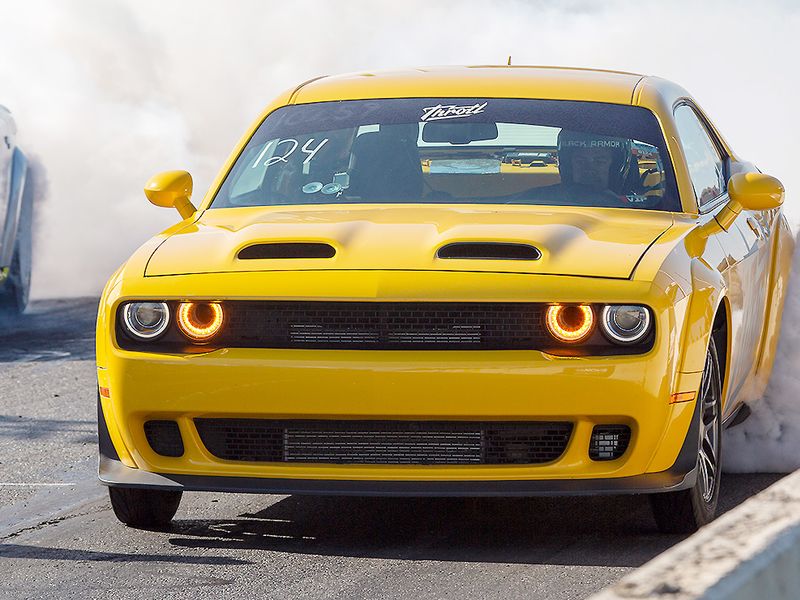
DETROIT — Dodge’s move into electrification could broaden its consumer base, but executives know the success of that shift also will depend on their ability to retain buyers who have been drawn to its high-octane Hellcats and Scat Packs over the years.
Dodge CEO Tim Kuniskis said the automaker understands that some are leery about its plans, so the performance brand will be laying out its vision in the months ahead to give enthusiasts an idea of what to expect from its electrified products.
Dodge will present its electrification plans in the fourth quarter as it prepares to launch a plug-in hybrid model in 2022 and a battery-electric muscle car in 2024, Kuniskis said. The brand also will provide a glimpse into the future next year with an electric concept car.
“We hope that we draw a different type of consumer, and keep the consumer that we have today,” Kuniskis told Automotive News during a media preview for the Roadkill Nights Powered by Dodge event, which featured Hellcat thrill rides and drag racing. “That’s very important to us, and that’s why we want to get our concept car out next year and explain to people exactly what we’re going to do. When things go into an electrified environment, we want to explain to people: Dodge muscle car first. And, by the way, it happens to have electrification to make it better.”
The upcoming electrified vehicles will live on for a “long time,” Kuniskis said, and set the direction for Dodge at a time when Stellantis CEO Carlos Tavares is affording each of the 14 brands brought together from Fiat Chrysler Automobiles and PSA Group a 10-year window to prove themselves.
Kuniskis shepherded Dodge’s image makeover from a budget-friendly brand of family haulers to an attitude-laden purveyor of muscle cars. Now he’s guiding it into an era of eco-friendly performance that he says will improve on what Dodge offers today.
This work is being done as Kuniskis makes a transition of his own working for Stellantis, which has given him the opportunity to hear from those with different perspectives.
Dodge’s importance to the merged company was evident during Stellantis’ EV Day in July, Kuniskis said, when it was one of six brands included. During that event, Kuniskis announced the electric muscle car and quipped that if a charger can make the Charger quicker, “we’re in.”
“Carlos Tavares is a very, very smart guy, and he looked at it and he said this is very, very unexpected,” Kuniskis said of Dodge’s EV rollout. “Let’s really shock the world. We’re serious about this. We’re so serious about it, we can take something that you don’t think can be electrified and we can keep it true to what it is, and keep it cool and keep growing this brand.”
While newly formed Stellantis and the rest of the industry set ambitious EV goals, U.S. sales for Dodge were blazing in the second quarter for its roaring internal combustion engines. They surged 95 percent for the Charger, 53 percent for the Durango and 52 percent for the Challenger.
The limited-run 2021 Durango SRT Hellcat, with 710 hp for a starting price of $82,490 including shipping, sold out quickly, and Dodge ended up building 3,000 of them — 1,000 more than anticipated.
Kuniskis said the heart of the muscle car market is around $40,000 to $50,000. He wouldn’t say whether Dodge will hit that range with its EVs but declared that “we know who our customer is, we know what our customers are looking for and we’re targeting exactly what we need to do.”
David Kelleher, chairman of the Stellantis National Dealer Council, recalled speaking with Kuniskis years ago about the possibility of an electric Dodge. He said Dodge can still be true to itself once it adds plug-ins to the mix.
“We can be who we want to be, it’s just propelled differently,” Kelleher said. “Why can’t we have a Charger that is the fastest out there? What’s the difference? If it’s the roar of the engine, artificially put a roar in there. We can do that.”
Karl Brauer, executive analyst for iSeeCars.com, said Dodge has had a lot of fun with performance cars in recent years. “I think they’re going to make sure they do the same thing with EVs,” Brauer said, “which could be really cool and could help to kind of further break through any resistance from muscle car fans for EVs.”
When asked how much horsepower Dodge is aiming for with its EVs, Kuniskis said that’s less important than how it performs.
“You want a Hellcat with 1,200 hp? I can give it to you,” he said. “It won’t be any faster than the one you got, because all you’re going to do is spin the tires. I don’t know what the horsepower is going to be, but trust me, we won’t disappoint you.”

